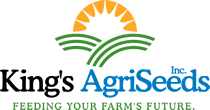Rod Porter, Northern Region Coordinator, Trumansburg, NY
As fall approaches, here are some points to consider as you make your final harvests for the year.
Hay: Try to time your final cutting to be 3 weeks before the killing frost or wait until after killing frost has come. To maintain a strong stand be sure to leave at least a 4” stubble for the post frost cuttings.
Pasture: In general, it is best to follow the same protocol as for hay, however, grasses are less sensitive to the timing of last grazing (or cutting). Pastures that contain a large amount of ryegrass should be left with a shorter stubble compared to other grasses for best survival as they are more prone to smothering and snow mold. If you are planning to frost seed in the Spring, grazing later and shorter will leave a more open canopy to seed into and slow early growth. On the other hand, a residual stubble of 4-6” will give an earlier, stronger growth in the spring.
Corn: It is necessary to monitor maturity and disease this fall as the rainy conditions in June and July have caused uneven crop progress, within the same field sometimes, and the constant dampness will increase the potential for diseases. Additionally, as of 7/31 most areas are a little behind in heat units. If you have plans to harvest both grain and silage, scout fields and earmark more variable and later maturing fields for silage, leaving more uniform and more mature fields for grain harvest. When disease shows up, monitor closely because if the disease progresses fast, whole plant moisture can drop quickly and end up too dry for silage. Remember, optimum corn silage moisture is 65-68% but not everything can be harvested at that precise moisture so be ready and start early! With corn silage a little wetter is better.
Sorghum/sudan products: Do not graze or feed fresh forage for 7-10 days following a hard frost. A light frost that only burns a few leaves will not cause a problem with prussic acid but a harder frost will.
Cover Crops: Pay attention to planting windows for different species when planting after fall crop harvests. See more information elsewhere in this newsletter.
Speak to an expert at King’s AgriSeeds now at 1-717-687-6224 or email us at [email protected].
